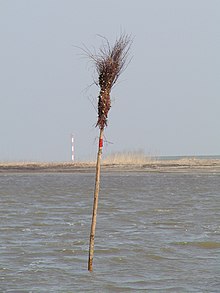Prick

The lamprey or Prigge is often in the Wadden Sea used fairway marking . Young birch trees , about five to seven meters high, or poles with tufts of twigs are mostly used for this.
Fairway
The pricks or poles mark a narrow and shallow fairway (mostly in the Wadden Sea), in which buoying would be too expensive or not possible due to insufficient water depth. In contrast to the usual buoying, usually only one side of the fairway is staked out.
Starboard (coming from the sea): rods stuck into the ground, at the upper end of which twigs tied together at the top, which are bent apart at the bottom, were attached (pointed shape), they usually carry a small green reflective ribbon (colloquially called "fir trees").
Port side (coming from the sea): birch trees or poles stuck into the ground, at the upper end of which twigs were attached at the bottom (blunt shape), the poles usually carry a small red reflective ribbon (colloquially "birch" or "broom").
Port pricks are mainly used because the branches do not have to be worked on. A fairway with port poles is also popularly called Besenstraße, because it looks like brushwood brooms that have been turned upside down.
Pricking must be passed at a distance of about three to five meters. As a rule, pricks do not survive the storms and ice drifts of winter and have to be set anew every year. Nowadays, prickers are used to set the prickers .
The direction of the fairway is taken from the nautical charts .
Mudflat hiking trails
To mark mudflat hiking trails, bush pricks or bush beacons are dug into the mudflats without poles. These path markings, which are approx. 1 m high, are at great risk from the ice . In addition, the priele migrate a few meters every year. That is why the bush prick is usually re-created in spring.
Web links
- Duden , accessed on January 23, 2013.
